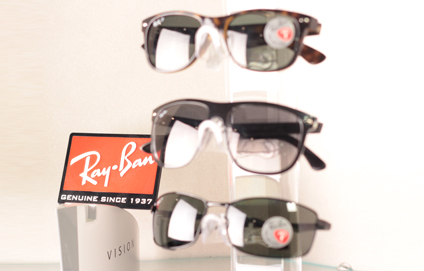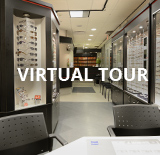Prescription Sunglasses
The sun emits many different types of light. The types most likely to injure the eye are ultra-violet (UV), blue light and bright or intense light. UV light rays carry more energy than visible light rays, so the eye is at a greater risk of damage from absorbing this type of light. UV light absorption by the eye can cause, or speed up, the progress of several diseases that affect the eye. Most of the damage caused by UVA and UVB rays happens over a long period of time and cannot be reversed.

Sensitivity to UV light radiation varies from one person to the next. Blue light is visible light in the blue portion of the colour spectrum. Intense glare of light reflecting off snow or water contains blue light. Your eyes cannot clearly focus in blue light. Some scientists believe routine exposure to blue light over many years may age the retina and increase the risk of blindness in some people over the age of sixty.
How Light Damages the Eye
All light is a form of energy. When your eyes absorb light, the process creates heat or chemical reactions in eye tissue. These reactions can cause permanent damage if the eye’s natural ability to heal itself is overwhelmed.
Different parts of the eye absorb different kinds of UV radiation and light. For example, the surface layers of the outer part of the eyeball (the cornea and the conjunctiva) absorb UVB rays. The lens absorbs mainly UVA rays. The retina (the light-sensitive lining at the back of the inner eyeball) absorbs visible light. If eyes are overexposed to ultraviolet radiation, the front portion of the eyes may be damaged. If visible light is too bright or intense, or if you stare directly at the sun, even briefly, the retina can be damaged, causing permanent loss of vision (even if wearing sunglasses).

There is some evidence that daily exposure to UV radiation in very bright sunlight over many years may increase the risk of developing cataracts. Cataracts cause a gradual clouding of the natural lens of the eye. You can minimize your risk with properly chosen sunglasses that will protect your eyes against damage from UV rays, bright light, and blue light. There are also other safety factors to consider. For example, if you are driving a vehicle in bright sunlight, it is safer to wear sunglasses, as they reduce glare and improve contrast.
At our dispensary we offer a wide selection of prescription & non-prescription sunglasses. Prescription sunglasses can be made in almost any eyeglass frame, with options including different coloured tints, polarized lenses and mirror coatings.
Back


